United B777 engine failure
A few comments - I won't bother quoting the exact posts since the mods have been removing much of the quoted posts.
ETOPS - part of the ETOPS equation is that most engine failures occur during takeoff or initial climb, not during the ETOPS portion of the flight. Failures - particularly catastrophic failures - are very rare at cruise. This is also true of FBO events. While a FBO can happen anytime, it's most likely to occur during takeoff or climb since that's when the fan blades experience the highest loads.
As I've posted previously, it was discovered during the 777 development program that some of the assumptions that had been used for FBO loads to the nacelle and engine structure were not valid - at least not for the (then) new generation of very large, very high bypass engines. As a result, higher FBO loads were used during for the 777 and subsequent programs. Recent experience suggests those loads need to be re-evaluated.
The PW4000/112" engine and the associated installation is out of production - and has been for about 15 years. That results in different treatment of things like these FBO events than would have resulted if it was still being produced (expanding fleet). Instead, analysis is done of the probability of a future, catastrophic event given the size of the existing fleet and how long it will remain in service. Hence, a relatively small fleet such as the PW4000/777 will be treated differently than a large fleet such as the 737NG/CFM56. No first hand experience (retired before the first PW4000/112" FBO event), but the process will look at the probability of a future PW4000/112" FBO event - presumably with some mitigation factor for more frequent, improved inspections - with additional probabilities assigned for the chances of a future event becoming catastrophic (remember, as dramatic as this event was, no one was hurt and the aircraft did not suffer serious damage - granted the next one may not be so lucky, there is a good chance it would). That process will determine what - if any - additional steps are required to maintain the expected level of safety. Now, before anyone starts in on their criticisms, know that while there are some Boeing specifics in the process that will be applied - the process itself is used throughout the industry, with a high level of FAA and other regulatory involvement.
Not privy to details, but the recent 777/PW4000 and 737NG events appear to share a common theme - fan debris is going forward of the containment ring and damaging the inlet/nacelle - leading to structural failure of the inlet and nacelle. This is something new - I don't recall that ever been seen before a few years ago. There had been cases where fan debris impacted the inlet forward of the containment ring, but it was low enough energy that it didn't do meaningful damage. For some reason that's changed (my guess is it's related to the higher bypass ratios of the newer engines, but that's just a guess). However I believe that's where the focus need to go, since I doubt any engine installation out there is going to deal gracefully with high energy debris impacting the inlet/nacelle forward of the engine containment ring - the inlet and nacelle are simply not designed for that.
ETOPS - part of the ETOPS equation is that most engine failures occur during takeoff or initial climb, not during the ETOPS portion of the flight. Failures - particularly catastrophic failures - are very rare at cruise. This is also true of FBO events. While a FBO can happen anytime, it's most likely to occur during takeoff or climb since that's when the fan blades experience the highest loads.
As I've posted previously, it was discovered during the 777 development program that some of the assumptions that had been used for FBO loads to the nacelle and engine structure were not valid - at least not for the (then) new generation of very large, very high bypass engines. As a result, higher FBO loads were used during for the 777 and subsequent programs. Recent experience suggests those loads need to be re-evaluated.
The PW4000/112" engine and the associated installation is out of production - and has been for about 15 years. That results in different treatment of things like these FBO events than would have resulted if it was still being produced (expanding fleet). Instead, analysis is done of the probability of a future, catastrophic event given the size of the existing fleet and how long it will remain in service. Hence, a relatively small fleet such as the PW4000/777 will be treated differently than a large fleet such as the 737NG/CFM56. No first hand experience (retired before the first PW4000/112" FBO event), but the process will look at the probability of a future PW4000/112" FBO event - presumably with some mitigation factor for more frequent, improved inspections - with additional probabilities assigned for the chances of a future event becoming catastrophic (remember, as dramatic as this event was, no one was hurt and the aircraft did not suffer serious damage - granted the next one may not be so lucky, there is a good chance it would). That process will determine what - if any - additional steps are required to maintain the expected level of safety. Now, before anyone starts in on their criticisms, know that while there are some Boeing specifics in the process that will be applied - the process itself is used throughout the industry, with a high level of FAA and other regulatory involvement.
Not privy to details, but the recent 777/PW4000 and 737NG events appear to share a common theme - fan debris is going forward of the containment ring and damaging the inlet/nacelle - leading to structural failure of the inlet and nacelle. This is something new - I don't recall that ever been seen before a few years ago. There had been cases where fan debris impacted the inlet forward of the containment ring, but it was low enough energy that it didn't do meaningful damage. For some reason that's changed (my guess is it's related to the higher bypass ratios of the newer engines, but that's just a guess). However I believe that's where the focus need to go, since I doubt any engine installation out there is going to deal gracefully with high energy debris impacting the inlet/nacelle forward of the engine containment ring - the inlet and nacelle are simply not designed for that.
OTOH, as shown in the photo in post #142, something punctured the fuselage below the wing root and, in cruise, would presumably have caused decompression.
Now that being said, it doesn't mean the next time it won't penetrate the fuselage and cause a decompression - but that didn't happen on this event.
OldLurker
You can't just say "Oh, it happened less than 180 minutes time from an airport, so that's not ETOPS". It covers the whole flight, including procedures before departure.
My understanding was that the ETOPS cert was dependent on some certain, notably high, reliability standards. With the relatively modest numbers of Pratt-powered 777s, and the two events which have now afflicted the type in recent times (and bear in mind the other one did happen in cruise, out over the Pacific), has the type fallen below the required ETOPS standard ?
This seems to be the third Boeing grounding in eight years, when I don't believe any other manufacturer has had one. A bit disappointing.
You can't just say "Oh, it happened less than 180 minutes time from an airport, so that's not ETOPS". It covers the whole flight, including procedures before departure.
My understanding was that the ETOPS cert was dependent on some certain, notably high, reliability standards. With the relatively modest numbers of Pratt-powered 777s, and the two events which have now afflicted the type in recent times (and bear in mind the other one did happen in cruise, out over the Pacific), has the type fallen below the required ETOPS standard ?
This seems to be the third Boeing grounding in eight years, when I don't believe any other manufacturer has had one. A bit disappointing.
td:
That's fascinating. Because the blade separation is due to static overload, it requires a higher flight load to do so. So even though takeoff and climb represents a pretty small portion of the overall flight spectrum, the much larger time spent in the remaining portions of flight is not enough to allow the crack to propagate further and fail at a cruise flight load. It almost seems like that's been borne out in some of the incidents I remember, is it an industry wide trend? Sounds indeed like it could be used to support ETOPS certification.
Your explanation of the quantitative risk assessment is right on.
That's fascinating. Because the blade separation is due to static overload, it requires a higher flight load to do so. So even though takeoff and climb represents a pretty small portion of the overall flight spectrum, the much larger time spent in the remaining portions of flight is not enough to allow the crack to propagate further and fail at a cruise flight load. It almost seems like that's been borne out in some of the incidents I remember, is it an industry wide trend? Sounds indeed like it could be used to support ETOPS certification.
Your explanation of the quantitative risk assessment is right on.

Join Date: Apr 2014
Location: Boston, MA
Age: 50
Posts: 8
Likes: 0
Received 0 Likes
on
0 Posts
With the failure of a P & W engine on a 747, do you folks think they will change the inspections \ groundings to cover more airframes? Will the USAF ground the KC-46's?
article on the 747 engine failure: simpleflying.com/boeing-747-engine-parts-rain-down-on-dutch-village-after-engine-fire/
article on the 747 engine failure: simpleflying.com/boeing-747-engine-parts-rain-down-on-dutch-village-after-engine-fire/
Quite often the key stress component is a vibratory mode superimposing on static stress. One thing to check is the clock position of where the blade first strikes the casing.. across multiple events
Join Date: Aug 2008
Location: Far, Far Away
Posts: 195
Likes: 0
Received 0 Likes
on
0 Posts
It does not even matter if it was an ETOPS flight. ETOPS is an aircraft AND operator certification. You just don’t buy a 777 and automatically have ETOPS capability.
All ETOPS types are easily flown on one engine, and the aircraft systems required have plenty of redundancy, so it really comes down to engine reliability.
3 failures in 3 yrs doesn’t sound so bad. 3 failures that are nearly identical in 3 yrs sounds a bit worse. 2 of those failures in 3 months. Fatigue cracks found in 2010 and 2015, yet covered up with some pure BS. Ouch.
Now add in all the Pratt 4000 series issues (ex. 747-400 of of AMS the same day).
It will be interesting to follow.
All ETOPS types are easily flown on one engine, and the aircraft systems required have plenty of redundancy, so it really comes down to engine reliability.
3 failures in 3 yrs doesn’t sound so bad. 3 failures that are nearly identical in 3 yrs sounds a bit worse. 2 of those failures in 3 months. Fatigue cracks found in 2010 and 2015, yet covered up with some pure BS. Ouch.
Now add in all the Pratt 4000 series issues (ex. 747-400 of of AMS the same day).
It will be interesting to follow.
Join Date: Feb 2006
Location: USA
Posts: 487
Likes: 0
Received 0 Likes
on
0 Posts
NTSB Media Briefing
WASHINGTON (Feb. 22, 2021) NTSB Chairman Robert Sumwalt conducted a virtual media briefing Monday, Feb. 22, 2021, to provide an update on the agency’s investigation of Saturday’s engine failure incident on United Airlines flight 328. United Airlines flight 328 experienced a right engine failure after takeoff from Denver International Airport Feb. 20, 2021. The airplane returned safely to Denver; none of the 229 passengers or 10 crewmembers were injured.
Join Date: Jul 2013
Location: Within AM radio broadcast range of downtown Chicago
Age: 71
Posts: 842
Received 0 Likes
on
0 Posts
WSJ article for tomorrow's dated edition refers to an FAA AD issued in March 2019 in the wake of a similar occurrence (United 1175) in February 2018. Finally SLF/atty realized AD cite should be in NTSB report on that 2018 incident - report DaveReidUK had posted earlier.
So, link to AD 2019-03-01 pertaining to blade inspections and related:
2019-03-01.pdf (faa.gov)
So, link to AD 2019-03-01 pertaining to blade inspections and related:
2019-03-01.pdf (faa.gov)
Join Date: Sep 2010
Location: SNA
Posts: 23
Likes: 0
Received 0 Likes
on
0 Posts
Anyone know what this part is? The entire part is approximately 6 feet (2m) long and there is video on the usual news outlets of it hitting the pavement with quite a bit of force. FYI the miscellaneous photos on this site are interesting:
https://www.denverpost.com/2021/02/2...lorado-denver/

https://www.denverpost.com/2021/02/2...lorado-denver/

tdracer
The PW4000 112, GE90 etc have low examples of fan blade release, as is the case for the CFM-56-7's. These have larger chord blades in general compared to earlier fan designs, which may be helping in the path of the liberated part.
general comment not related to tdr... . Was queried on. my post #113 on the wording I used, and it needs clarification, and that is related to your observation so here goes...
. Was queried on. my post #113 on the wording I used, and it needs clarification, and that is related to your observation so here goes...
I commented on the release dynamics, noting the radial accelerations. This is more correctly stated as centripetal acceleration but has the same meaning, well at least in my limited language skills.
The fan disk transfers torque to the blade root, to counter the aerodynamic drag of the blade. The blade root transfers loads to the disk and VV through the fir tree root fittings for radial, in-plane loads. the root also absorbs the out-of-plane bending loads and also torsional loads. The blade has inertial and aerodynamic moments, and these all come to play in a failure. On the release of the blade it is free to depart the scene, and follows Nootin's 1st, translating outwards and along the tangent of the in-plane path, for a poofteenth of a second, until the tip contacts the inner wall of the annulus/rub strip, whereupon drag forces slow down the outer end of the blade, and inertia starts a rotation out of the radial alignment of the blade as built. The blade tip is a light structure, (designers are smart... ). the tip hitting anything including ice will deform, hitting the engine annulus is going to collapse the blade structure and leave a witness mark. That impact slows down the blade's outer end... at the same time, drag is moving the blade rearwards, and it approaches the following blade. Coincidentally, the lift force twists the blade out-of-plane, and the pitching moment gets a say on it's alignment, and it will start rotating LE downwards. About now, it gets the kick in the pants from the following blade, and gets pushed forward for a short while, while damaging the following blade LE at part span. rotating around its length, the blade develops Flettner style lift and gets carried forward for a short period of time.
Does the blade need to hit the intake lip to sever it? Probably not.... my guess... the out-of-balance of losing 1 1/2 blades on one arc of the fan is going to be quite impressive. Happy snaps will show if contact occurred, but I'm thinkingArby's... that the light structure will fail under high oscillatory loads. Maybe...
Then again, the blade may work like a chainsaw and chew its way through the structure, but, I doubt that is the case.
Sunil K. Sinha and Sreekanth Dorbala wrote an interesting paper on "Dynamic Loads in the Fan Containment Structure
of a Turbofan Engine" J. Aerospace Engineering July 2009, and stated in part:
"A typical fan blade-out event involves very complex nonlinear transient dynamics with large deflection of the release blade and rigid body rotation of the trailing blade as well as progressive failure and fragmentation of various components. Due to the nature of the impact type loading, the solution to the problem should also address dependence of the material behavior such as yield strength as a function of strain rates. In short, the transient dynamic analysis of a fan blade-out event highlights the complexity of the numerical technique, which includes all the nonlinearities of structural dynamics: plastic behavior of the materials, large displacements, and contact interaction between structural elements. In this paper, we present the results of a LS-DYNA simulation of a FBO event on a full-engine analytical model, which covers both the primary as well as secondary damages."
These guys did a neat analysis, however even using the LS-DYNA code it is a simplification of the dynamics of the release, and as far as I am aware, that remains the case to this day. The last time I looked at this was when we were doing some weird $&*T on fan blades doing a POC, and wondering where the stuff was gonna go fly. (in the end, our assumptions happened to be OK on the day, luckily, and we didn't blow up the test engine, the test cell, or the building).
Page 264, upper right paragraph under figure 4 "Comparison of von Mises stresses between ANSYS and LS-DYNA" has comments that say in a high tech manner what is stated above in lyrical prose. The 5th happy snap below tells a story of the engine response, why it pretty much disassembles itself. the image before that with the graphs indicates what is missing in the analysis and should be considered in relation to the observation of the paragraph mentioned on page 264 of their report.
Now, it could well be that the LS-DYNA code is absolutely correct, and if so, then we can expect to see plastic deformation at one particular point of the containment ring, and then we would come up with a new trajectory for the blade parts.... how do they get from point A to entry point X. My suspicion is that there is no penetration of the containment, and that should give a hint as to what to add to the code.
Gotta say I'm a bit miffed, I quite liked the 4094 donk, I would hope the failure is from an isolated cause such as inclusions or similar rather than a design of the blade, presuming that the 112" has a common blade P/N... which is probably the case.
Zeffy, thanks for the NTSB photos, that blade root is telling a story. The future of the 4000-112 series rides on the close-ups of that picture.
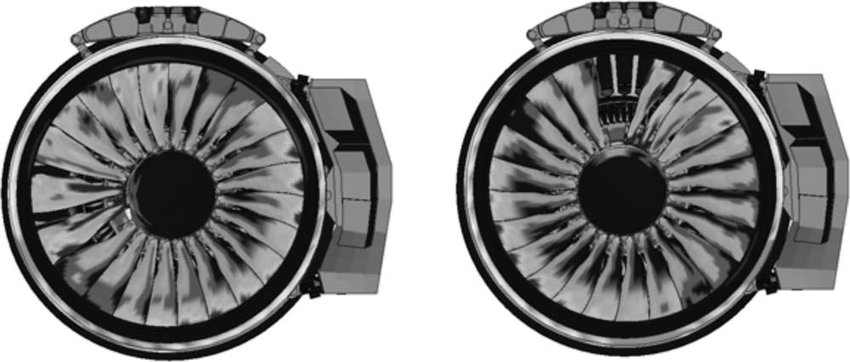
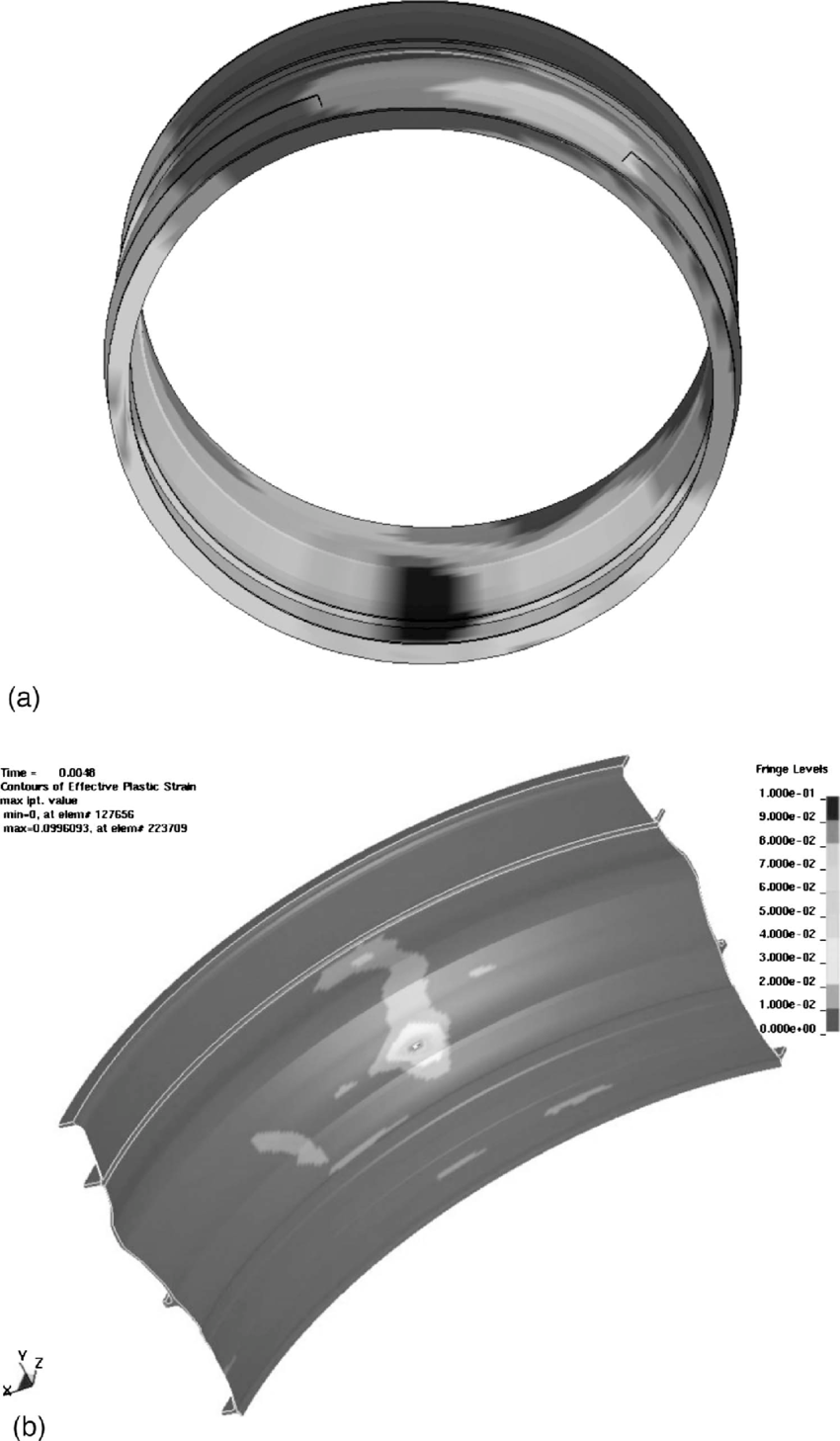

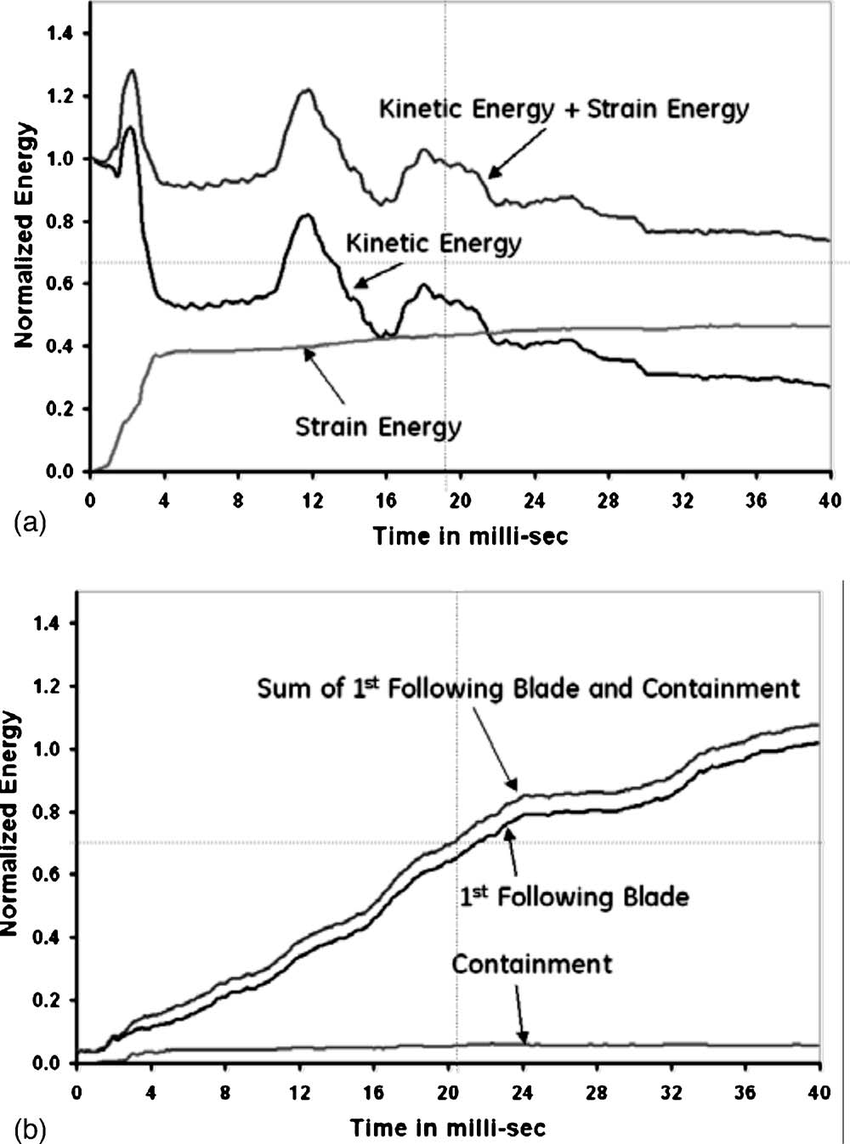
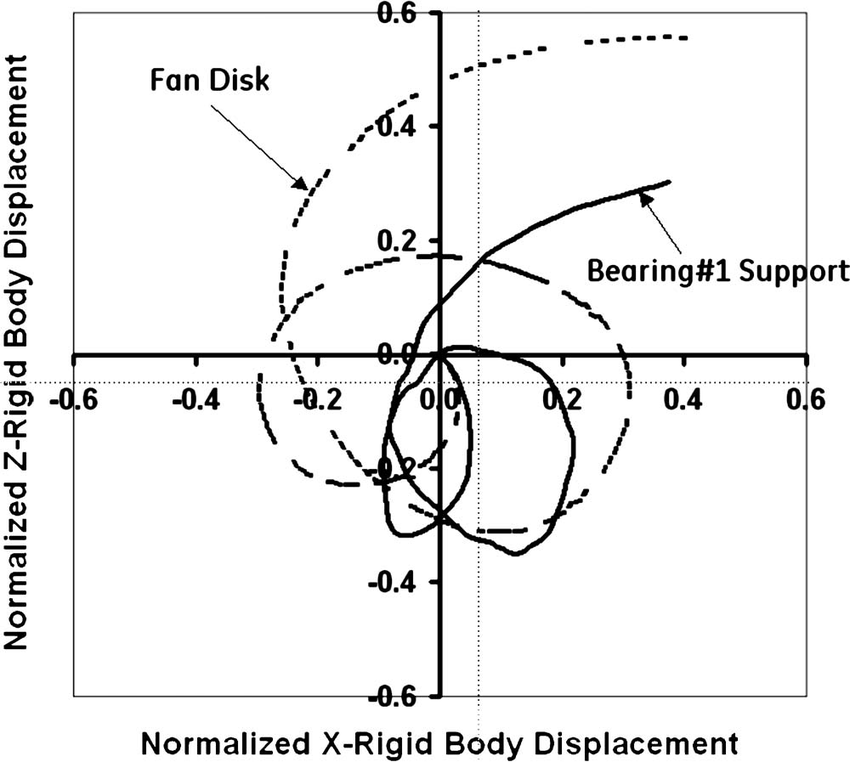
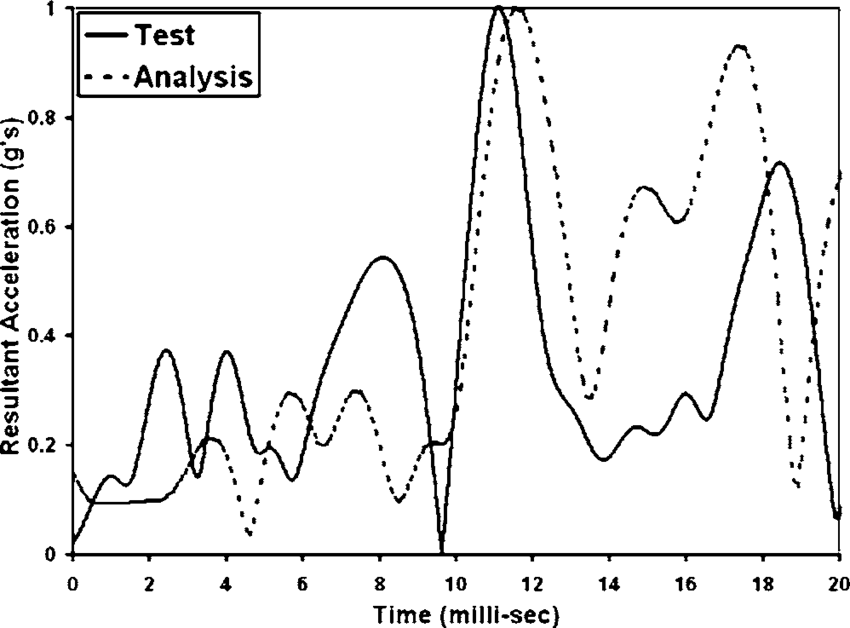
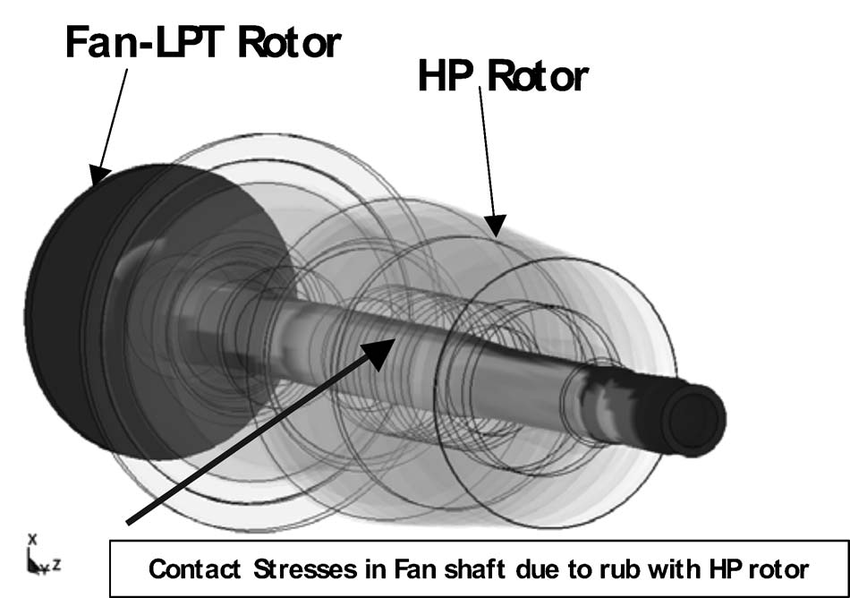

The PW4000 112, GE90 etc have low examples of fan blade release, as is the case for the CFM-56-7's. These have larger chord blades in general compared to earlier fan designs, which may be helping in the path of the liberated part.
general comment not related to tdr...
 . Was queried on. my post #113 on the wording I used, and it needs clarification, and that is related to your observation so here goes...
. Was queried on. my post #113 on the wording I used, and it needs clarification, and that is related to your observation so here goes...I commented on the release dynamics, noting the radial accelerations. This is more correctly stated as centripetal acceleration but has the same meaning, well at least in my limited language skills.
The fan disk transfers torque to the blade root, to counter the aerodynamic drag of the blade. The blade root transfers loads to the disk and VV through the fir tree root fittings for radial, in-plane loads. the root also absorbs the out-of-plane bending loads and also torsional loads. The blade has inertial and aerodynamic moments, and these all come to play in a failure. On the release of the blade it is free to depart the scene, and follows Nootin's 1st, translating outwards and along the tangent of the in-plane path, for a poofteenth of a second, until the tip contacts the inner wall of the annulus/rub strip, whereupon drag forces slow down the outer end of the blade, and inertia starts a rotation out of the radial alignment of the blade as built. The blade tip is a light structure, (designers are smart... ). the tip hitting anything including ice will deform, hitting the engine annulus is going to collapse the blade structure and leave a witness mark. That impact slows down the blade's outer end... at the same time, drag is moving the blade rearwards, and it approaches the following blade. Coincidentally, the lift force twists the blade out-of-plane, and the pitching moment gets a say on it's alignment, and it will start rotating LE downwards. About now, it gets the kick in the pants from the following blade, and gets pushed forward for a short while, while damaging the following blade LE at part span. rotating around its length, the blade develops Flettner style lift and gets carried forward for a short period of time.
Does the blade need to hit the intake lip to sever it? Probably not.... my guess... the out-of-balance of losing 1 1/2 blades on one arc of the fan is going to be quite impressive. Happy snaps will show if contact occurred, but I'm thinking
Then again, the blade may work like a chainsaw and chew its way through the structure, but, I doubt that is the case.
Sunil K. Sinha and Sreekanth Dorbala wrote an interesting paper on "Dynamic Loads in the Fan Containment Structure
of a Turbofan Engine" J. Aerospace Engineering July 2009, and stated in part:
"A typical fan blade-out event involves very complex nonlinear transient dynamics with large deflection of the release blade and rigid body rotation of the trailing blade as well as progressive failure and fragmentation of various components. Due to the nature of the impact type loading, the solution to the problem should also address dependence of the material behavior such as yield strength as a function of strain rates. In short, the transient dynamic analysis of a fan blade-out event highlights the complexity of the numerical technique, which includes all the nonlinearities of structural dynamics: plastic behavior of the materials, large displacements, and contact interaction between structural elements. In this paper, we present the results of a LS-DYNA simulation of a FBO event on a full-engine analytical model, which covers both the primary as well as secondary damages."
These guys did a neat analysis, however even using the LS-DYNA code it is a simplification of the dynamics of the release, and as far as I am aware, that remains the case to this day. The last time I looked at this was when we were doing some weird $&*T on fan blades doing a POC, and wondering where the stuff was gonna go fly. (in the end, our assumptions happened to be OK on the day, luckily, and we didn't blow up the test engine, the test cell, or the building).
Page 264, upper right paragraph under figure 4 "Comparison of von Mises stresses between ANSYS and LS-DYNA" has comments that say in a high tech manner what is stated above in lyrical prose. The 5th happy snap below tells a story of the engine response, why it pretty much disassembles itself. the image before that with the graphs indicates what is missing in the analysis and should be considered in relation to the observation of the paragraph mentioned on page 264 of their report.
Now, it could well be that the LS-DYNA code is absolutely correct, and if so, then we can expect to see plastic deformation at one particular point of the containment ring, and then we would come up with a new trajectory for the blade parts.... how do they get from point A to entry point X. My suspicion is that there is no penetration of the containment, and that should give a hint as to what to add to the code.
Gotta say I'm a bit miffed, I quite liked the 4094 donk, I would hope the failure is from an isolated cause such as inclusions or similar rather than a design of the blade, presuming that the 112" has a common blade P/N... which is probably the case.
Zeffy, thanks for the NTSB photos, that blade root is telling a story. The future of the 4000-112 series rides on the close-ups of that picture.








Are you suggesting that the NTSB's definition is wrong, or that the term is meaningless ?
Either way, it might be quite useful to have a term that's shorthand for "no rotating part of the engine was ejected radially", which is a bit of a mouthful but accurately describes this event.
Either way, it might be quite useful to have a term that's shorthand for "no rotating part of the engine was ejected radially", which is a bit of a mouthful but accurately describes this event.
So it is called contained while the airplane got hit and damaged by high energy fragments?
Join Date: Jul 2007
Location: Germany
Posts: 556
Likes: 0
Received 0 Likes
on
0 Posts
darobstacraw
The PW4077 as used on the 777-200 is a unique sub-variant as it is the only one to use hollow titanium alloy fan blades (similar to many RR Trent engines).
The 744 case in Maastricht was a completely different failure mode and a different variant of the engine. It seems to have suffered some catastrophic turbine blade failure, for reasons yet unknown, but also contained.
The PW4077 as used on the 777-200 is a unique sub-variant as it is the only one to use hollow titanium alloy fan blades (similar to many RR Trent engines).
The 744 case in Maastricht was a completely different failure mode and a different variant of the engine. It seems to have suffered some catastrophic turbine blade failure, for reasons yet unknown, but also contained.
The home pic on this link https://aviationtribune.com/airlines...w4000-engines/
is of the PW4000 series. On the bottom of the engine, in the 6 o’clock position, running length-wise are two similar piping ducts with matching insulation.
Going by the other pictures up thread of the engine damage/severe burns on the bottom half of the engine, parked on stand, it appears they’re the same ducts.
If so, I’d say they’re engine anti-icing ducts.
is of the PW4000 series. On the bottom of the engine, in the 6 o’clock position, running length-wise are two similar piping ducts with matching insulation.
Going by the other pictures up thread of the engine damage/severe burns on the bottom half of the engine, parked on stand, it appears they’re the same ducts.
If so, I’d say they’re engine anti-icing ducts.
Join Date: Jul 2007
Location: Germany
Posts: 556
Likes: 0
Received 0 Likes
on
0 Posts
Less Hair
The airplane was not hit by high-energy fragments. Those would have gone straight through. A non-structural fairing was hit by a low-energy fragment. Not something you want, but not a catastrophic (arguably not even "major") failure from the point of view of the aircraft.
The airplane was not hit by high-energy fragments. Those would have gone straight through. A non-structural fairing was hit by a low-energy fragment. Not something you want, but not a catastrophic (arguably not even "major") failure from the point of view of the aircraft.



